"Violet" Partly Photographed in 8-perf 65mm |
Read more at in70mm.com The 70mm Newsletter |
| Written by: Bas Devos, director, "Violet", in an e-mail to the editor | Date: 14.04.2014 |
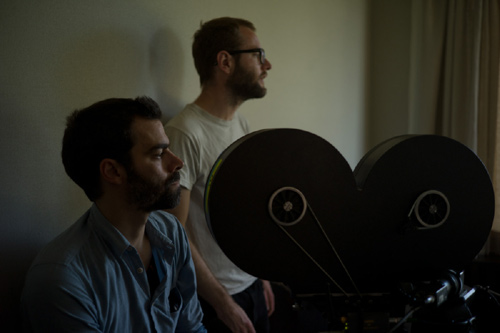 Director
of photography Nicolas Karakatsanis and director Bas Devos next to the 65mm
camera. Director
of photography Nicolas Karakatsanis and director Bas Devos next to the 65mm
camera.We shot in an 8-perf format to approach the 4:3 ratio. A huge negative indeed. The camera we used is the 65MM 8-perf Mitchell Todd-AO. Our DOP Nicolas Karakatsanis bought the camera on eBay. We wanted to achieve a heightened reality for certain shots. The film is about observing, the action of watching. So the large format was almost logic - even though it was hard on our small production. Approx. 12 min in the films final cut is 65mm footage. This includes a monolithic ending sequence of 6˝ min. Due to the length of an 8 perf 65mm reel, we had to cut the shot in two parts and stich it together in post to have one fluent 6˝ min shot. Bas Devos, director, "Violet" |
More in 70mm reading: Various Large format and 70mm Films Internet link: violet-film.com mindsmeet.be augusteorts.be How They Achieved This Stunning 4:3 Film’s Most Stunning Shots |
From The Media |
|
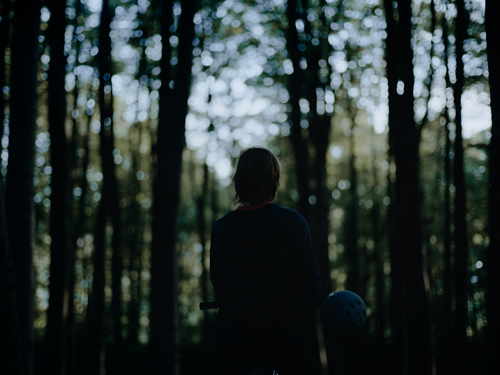 65mm
8-perf frame blow-up 65mm
8-perf frame blow-uptheupcoming.co.uk: Talking about lenses – Violet has a 4:3 ratio and exceptional cinematography. What was it shot on? Bas Devos: I had my mind made up on the ratio from the very start. It’s because we’re so used to the Cinemascope nowadays that a different ratio immediately prompts a different way of looking. It’s a photographic format. Our approach to cinematography was more photographic than cinematographic – especially in search of the light and the way we used lenses. Most parts we shot on Arri Alexa, another ten minutes – the whole ending sequence – was shot on 65mm. We found an old camera with eight perforations – that’s like the Hasselblad format within 24 frames a second, it gives you a very strange focal depth. |
|
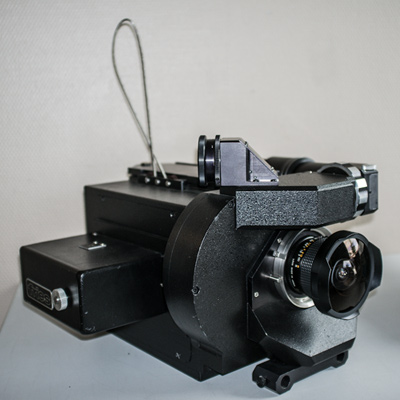 theskeletonherald.blogspot.dk theskeletonherald.blogspot.dkFries Todd-AO 65mm 8-perf camera with Mamiya 645 24mm lens in Maxi PL-mount (without 1000ft mags on this picture). Prepping a Bas Devos feature film. hollywoodreporter.com: Emotionally specific despite relying mostly on images rather than dialog to tell its story, this evocative and atmospheric feature, which was shot on both 65mm and the digital Alexa by co-producer and ace cinematographer Nicolas Karakatsanis (Bullhead), should appeal to upscale festival and arthouse audiences and might even score some niche theatrical action in other European territories. The film’s boxy Academy ratio helps lend the proceedings a claustrophobic edge, as if the screen can’t contain the churning undercurrents of emotions, while the images in 65mm make the film look almost hyperrealistic at times, suggesting a heightened sensitivity to Jesse's experience of his surroundings. |
|
Synopsis |
|
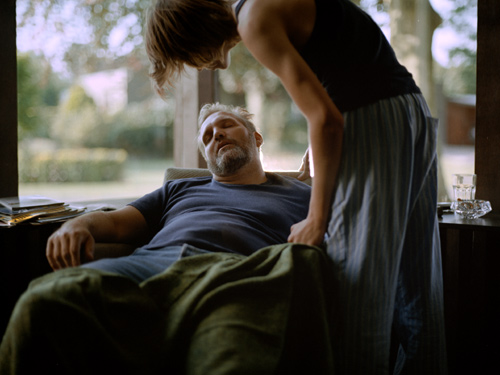 65mm
8-perf frame blow-up 65mm
8-perf frame blow-upOn their way home early one summer, Jesse and Jonas get into an argument with two youngsters, whereby Jonas gets stabbed. Jesse is the only witness of the murder. In shock, Jesse, is taken care of by his parents. They are at a loss for words. All Jesse’s circle of friends, a group of young BMX riders, can come up with is questions – questions Jesse is unable to answer. The group do their best to take care of him, taking him to the skate ground and to concerts. Feeling the weight of their looks, however, Jesse increasingly isolates himself to get over the loss. At nights he sneaks towards Jonas’s parents’ house. He takes a certain amount of comfort from observing those who share his grief. When Jonas’s father catches him in the act one day and gives him Jonas’s old BMX as a present, Jesse gradually starts realizing what is happening to him. He realizes that a visit to the scene of the crime will be the only way to get over the loss and confront his loneliness. |
|
Director's Statement |
|
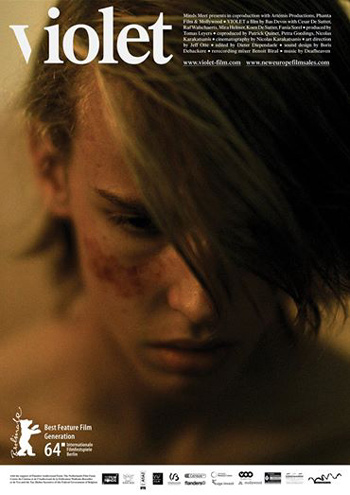 The way the formal aspects of
film and films materiality can dictate the
content has always intrigued me. The way light and dark, noise and
silence and time and space alter the meaning of what is shown is vastly
enigmatic and seemingly beyond comprehension. Often I found myself moved
not by what was shown but by how it reached me. I connected to certain
films because, on a deeper level, I connected to the way the filmmaker saw
the world. How the light wakes up a space or how the screen-space
separates two people. How screentime feels like private-time or how
complete silence makes me aware of my own presence, my own posture.
These sensory experiences defined and redefined how I perceive the medium. I
love stories. I love telling them. Drawing them. But in lm I felt much
more attracted to something on the border of the narrative. I wanted to
lm windows. And lamps. And res. The way the formal aspects of
film and films materiality can dictate the
content has always intrigued me. The way light and dark, noise and
silence and time and space alter the meaning of what is shown is vastly
enigmatic and seemingly beyond comprehension. Often I found myself moved
not by what was shown but by how it reached me. I connected to certain
films because, on a deeper level, I connected to the way the filmmaker saw
the world. How the light wakes up a space or how the screen-space
separates two people. How screentime feels like private-time or how
complete silence makes me aware of my own presence, my own posture.
These sensory experiences defined and redefined how I perceive the medium. I
love stories. I love telling them. Drawing them. But in lm I felt much
more attracted to something on the border of the narrative. I wanted to
lm windows. And lamps. And res.The surface of things. The surface of people. "Violet" departs from an act of violence. It initiates a very simple narrative: a process of grief and loneliness through the eyes of a teenager. Both in form and content the film tries to disarm the violence of its opening. The cruel, distant observation of a murder through a cctv monitor, in its silence and indifference, was a necessary start. It was for me a force, a presence that demanded opposition. Not relying on a defined psychological drive, but on the tools of film, I hoped to evoke something of the isolation and powerlessness of the main character. Through observing him and his surroundings, I believe something can be seen that is harder to articulate, but that has a stronger power than the underlying violence. A belief, maybe, that people connect not in what we understand but in what we do not. Maybe here for me content and form truly converge, in not knowing why exactly things are the way they are. Finally, I would like to stress the obvious. This film is not the work of one, but of many makers. Every member of the cast and crew helped me, not in ‘realizing my vision’, but in letting me see, hear and feel things in a different way, previously unimagined. Bas Devos |
|
Cast/Credit |
|
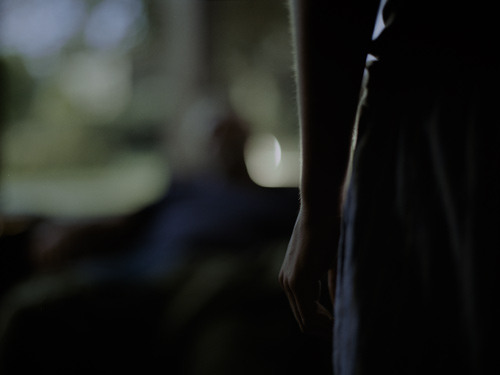 65mm
8-perf frame blow-up 65mm
8-perf frame blow-upMinds Meet presents in coproduction with Artémis Productions, Phanta Film & Mollywood: Violet. A film by Bas Devos with Cesar De Sutter, Raf Walschaerts, Mira Helmer, Koen De Sutter, Fania Sorel, Brent Minne. Produced by Tomas Leyers. Coproduced by Patrick Quinet, Petra Goedings, Nicolas Karakatsanis. Cinematography by Nicolas Karakatsanis. Art direction by Jeff Otte. Edited by Dieter Diependaele. Sound Design by Boris Debackere. Rerecording Mix by Benoit Biral. Music by Deafheaven. 2014 – BE / NL – DCP – Colour – approx. 85 min. Shooting Format: ARRI Alexa, 65mm 8 perf. violet-film.com, info@mindsmeet.be "Violet" had its World premiere at the Berlin Film Festival in February 2014 and won the Generation 14 plus International Jury prize. "Violet" was show at the CPH PIX film Festival in April 2014, Copenhagen, Denmark. |
|
| Go: back - top - back issues - news index Updated 22-01-25 |
